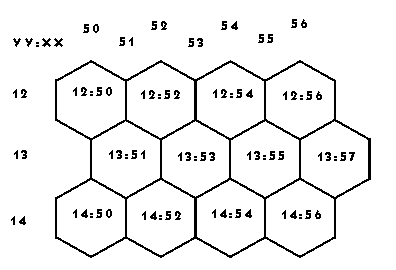The Game Map
The Savage Frontier is a vast landscape of many terrains, from forest to plains, mountains to swamps. The map is subdivided into hexagons. Each hexagon represents an area roughly 15 to 20 miles across.
Each hexagon has a unique four-digit number to identify it. The first two digits represent the vertical axis (the row) of the map and run from 00 (the top of the map) to 99 (the bottom). The last two digits represent the horizontal axis of the map (the column). On even numbered rows the column numbers run from 00 (the left side of the map), even numbers only, to 98 (the right side of the map). On odd numbered rows the column numbers run from 01 (the left side of the map), odd numbers only, to 99 (the right side of the map).
When map coordinates are given in text, the vertical coordinate (row number) is always separated from the horizontal coordinate (column number) by a colon. Thus 99:01 is in the lower left corner of the map, 01:99 is in the upper right corner, and 50:50 is dead center.
Since the map hexagons make staggered rows, with the columns of one offset from those above and below it, not all coordinates specify hexagons. For example, 79:80 is not a hexagon that appears on the map; by convention all the column numbers are even in even-numbered rows, and odd in odd-numbered rows. To give a few more examples, the northwest-most hexagon on the map is referred to as 00:00; the hexagon directly to the east of it is 00:02, and the hexagon to the southeast of it is 01:01.
Familiarize yourself with the map and its numbering system; you will use this
system to locate your units and communities on the map. An illustration of the
hexagon numbering system used in War of the Avatars:

The Savage Frontier is bordered by the Sea of Swords to the west, by the nearly desolate lands of Icewind Dale and the Reghed Glacier to the north, and by the Anauroch desert to the east. The scope of this game does not include sea travel, so sea hexagons are impassable. The bulk of the Anauroch desert is thought to be unpopulated and therefore thought to be of little economic value to a realm, but it is also said to be peppered with ruins, dungeons, and lairs...
Each hexagon is dominated by a certain terrain. This terrain can range from volcanoes to grassland to forest. The terrain affects the speed with which a unit can move through the hexagon, which races are likely to be found there, and other factors as well.
Roadways: There are many different roads and trails across the map. Roads are heavily traveled and movement along them is relatively swift (1/2 of the hexagon's normal movement cost, rounded up, when moving from one road hexagon to another). Trails are rougher, but they are still easier than traveling cross country (3/4 of basic movement cost, rounded up). Roadways may be thought of as running from the center of one hexagon, to the center of an adjacent hexagon, and do on. Roadways affect movement only between hexagons so connected. There is no advantage (or disadvantage) to crossing roads.
Waterways and Bridges: Many rivers and streams flow through the Savage
Frontier. They may be thought of as running between hexagons, along the edges
that separate them. Travel between hexagons separated by a waterway takes
longer (twice the normal movement cost of a hexagon entered by crossing a
river, 1 1/4 the cost for entering across a stream, rounded up). A roadway
(connecting two hexagons) shown crossing a waterway (which divides the
hexagons) indicates the presence of a bridge. A unit traveling on a bridge is
subject to both the effects of the waterway and the roadway. Note that
following a road across a river effectively results in canceling effects (the
road halves the cost, but the river doubles it), so the net result is normal
cost to enter a hexagon following a road across a river.




| P.O. Box 22400 Tempe, AZ 85285 (480) 967-7979 fax (480) 894-2028 |